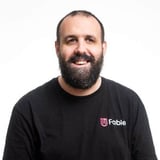Summary
Many organizations struggle with justifying and prioritizing accessibility. One of the primary reasons is because they’re thinking about accessibility all wrong. Instead of a checklist, a list of legal requirements, or a set of shackles holding designers and developers back, it’s time to start thinking of accessibility as what it is: an opportunity to innovate! In this presentation, Fable will draw from our expertise helping organizations like yours start the accessibility journey, to change the way you think about disability, assistive technology, and accessibility. We will demonstrate that accessible products are more flexible, customizable, and useful for all users. We’ll also show you how accessibility is directly tied to the creation of many of the most exciting and innovative technologies of the last 50 years, and how it’s changed the entire world for everyone. This presentation will inspire you with the information and ideas you need to accelerate your accessibility journey.
Key Insights
-
•
Many accessibility features like dark mode and voice assistants began as disability aids and are now mainstream because they improve experiences for all users.
-
•
One in five people live with long-term disability, and everyone can experience situational or temporary disabilities throughout life.
-
•
Accessible design is about creating flexible, customizable products rather than oversimplified or lowest-common-denominator solutions.
-
•
Diverse teams lead to innovative, inclusive products by uncovering use cases and solutions that homogeneous teams might miss.
-
•
Accessibility is a journey, not a one-time checklist fix, and must be integrated continuously into research, design, and development.
-
•
Disability is a universal and changing identity, highlighting that accessible products design for our future selves.
-
•
Humanizing accessibility by involving people with disabilities in training and product testing builds empathy and better buy-in.
-
•
Major companies like Facebook, Apple, and Microsoft embed accessibility as part of their core product experiences, showing its feasibility.
-
•
Innovations originally designed for accessibility, such as GPS and electric toothbrushes, often become more widely adopted because they offer superior usability.
-
•
Data sonification and advanced APIs allow vision-challenged users to access complex visual data like graphs in new ways, signaling ongoing innovation.
Notable Quotes
"Dark mode started off as an accessibility feature for visual challenges and eventually became mainstream because it’s so valuable for everyone."
"Everyone uses voice assistance now, whether controlling a smart home or sending a quick text; it gives independence to people with disabilities and convenience to all."
"Disability is the only identity that all of us will probably adopt at some point during our lives."
"If we are designing experiences that don’t work for everyone today, we’re designing experiences that in a couple of years will exclude ourselves."
"Accessible design is not about shackles or lowest-common-denominator; it’s about building great, flexible experiences for everyone."
"The Last of Us 2 was the first console game a completely blind person could play from start to finish by adding innovative, customizable accessibility features."
"Separate accessible designs are never equal, so we must design inclusively from the start to unlock all the benefits of accessibility."
"It is cheaper and better to do accessibility right the first time than to retrofit and fix later."
"Bringing people with disabilities into ideation and prototyping helps build accessibility by design and eliminates costly retrofits."
"Disability is normal, not shameful or rare, and everyone can benefit from accessibility innovations."
Or choose a question:
















More Videos

"The user experience will allow us to win."
Doug PowellClosing Keynote: Design at Scale
November 8, 2018

"Make sure children understand they can stop the session at any time, and confirm they really get that."
Mila Kuznetsova Lucy DentonHow Lessons Learned from Our Youngest Users Can Help Us Evolve our Practices
March 9, 2022

"Artifacts of the future help us envision and grasp the change that we’re hoping to have—it’s not just bullet points or vision statements."
Sarah GallimoreInspire Progress with Artifacts from the Future
November 18, 2022

"We can’t complain about not having a seat at the table if we don’t offer one of our own."
Lada Gorlenko Sharbani Dhar Sébastien Malo Rob Mitzel Ivana Ng Michal Anne RogondinoTheme 1: Discussion
January 8, 2024

"Nobody can predict where we’re going, but we can choose to shape the future."
Alnie FigueroaThe Future of Design Operations: Transforming Our Craft
September 10, 2025

"If you measure an infinite number of customers, every change would be statistically significant, but not every change would be meaningful."
Landon BarnesAre My Research Findings Actually Meaningful?
March 10, 2022

"In public radio, your listener can’t rewind. We have to design for thoughtful user progression."
Emily EagleCan't Rewind: Radio and Retail
June 3, 2019

"Legacy applications linger because changing them is risk-ridden and a major undertaking."
Malini RaoLessons Learned from a 4-year Product Re-platforming Journey
June 9, 2021

"Designers are often seen as bottlenecks because our work is harder to estimate and track than engineering’s."
Asia HoePartnering with Product: A Journey from Junior to Senior Design
November 29, 2023
















